fruit
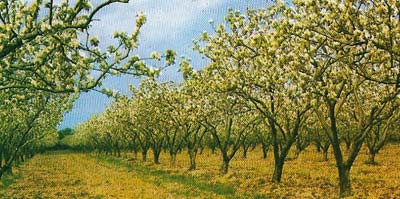
Figure 1. Commercial apple orchards in England are found throughout the region south of a line joining the Mersey and the Wash. Most cider apples are grown in the West Midlands and in the West Country.
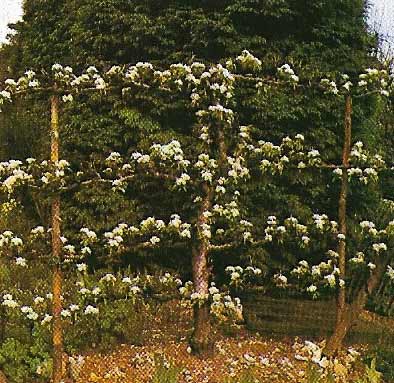
Figure 2. Fruit trees in gardens are grown on a smaller scale and can be trained against a wall espalier style, like this pear tree, so as to take up less space and not shade other plants.
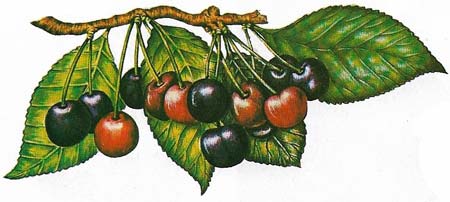
Figure 3. The cherry is a type of fruit known as a drupe, which takes the form of a single seed surrounded by fleshy fruit. Cherries date from Roman times and the one shown is the black Early Rivers variety.
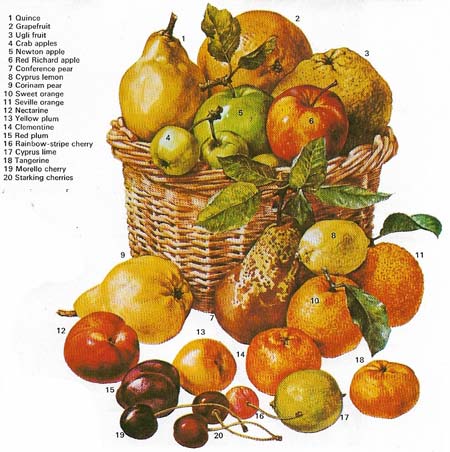
Figure 4. Modern fruit is a result of thousands of years of selection of chance seedlings and mutations (sports) and, during the last 200 years, of controlled breeding. Large apples were developed fro species such as the crab apple (Malus sylvestris). Pears (Pyrus sp), plums, and cherries (Prunus sp) were derived from wild European species. The quince (Cydonia sp) originated in the Middle East, citrus fruits (Citrus sp) in the Far East. Modern techniques make fruit available at any time.

Figure 5. The apricot also belongs to the genus Prunus but is less hardy than the plum, requiring protection from frost and fungal diseases. The yellow and orange-colored fruits are rich in sugar and contain iron and vitamin A.
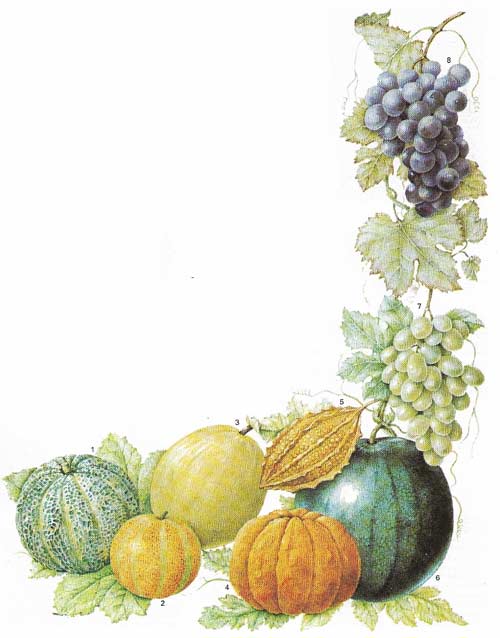
Figure 6. Melons and grapes both need a great deal of sun and water. The fruits of the melon may need to be supported in nets while growing. Most grapes are grown for wine but many fine varieties are grouse as desserts or for drying.
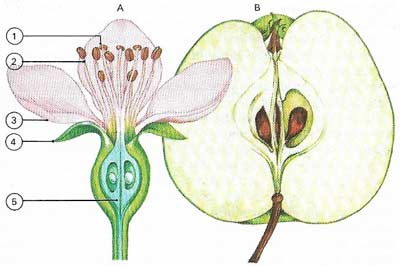
Figure 7. Apple blossom (A), when examined, shows features typical of an angiosperm flower – stigmas (1), stamens (2), petals (3), sepals(4), and an inferior ovary (5) (one that lies below the other flower parts). After the ovaries have been fertilized (usually by bees), the flower parts fail away leaving the receptacle (the "box" containing the ovaries) to become fleshy and swell and grow into the fruit. The flesh of the fruit (B) is formed from the receptacle wall while the ovary wall remains as the leathery core. In other fruits different parts of the ovary structure may become the fleshy portions of the plant that are edible.

Figure 8. Astonishing variety characterizes the tropical fruits. Akee (A), a though a fruit, is cooked as a vegetable and tastes like a fine omelette. When the fruit ripens it bursts open to reveal fleshy cream-colored arils, the edible parts of the akee. Jack fruit (B), a giant which might weigh up to 31 kilograms (70 pounds), may be eaten raw or cooked. It has an unpleasant odor when cut, but the flavor of its creamy yellow pulp is more appealing. The sapodilla (C) is a Central American fruit with rough brown skin and a slightly grainy pulp. The sweet, khaki-colored flesh tastes like faintly astringent brown sugar. It is eaten when fully ripe. Papaya, or pawpaw (D), sprinkled with lemon juice and sugar, is eaten for breakfast in the tropics. Its smooth skin ripens from green to yellow or orange and its succulent pulp encloses small black-brown seeds in its center. Papain, an enzyme contained in the leaves and unripe fruit, is used to tenderize meat. The coconut (E) has a hard, fibrous outer shell and a hollow center. Its flesh is most familiar in the West in its desiccated form. The soft translucent flesh of an immature coconut is enjoyed only in the tropics. One of the world's most important crops, the coconut derives its name from coco – a Portuguese word meaning grimace – because it resembles a grinning human face.

Figure 9. Native to Malaysia, the red fruit of the rambutan (A) is covered with soft spines. Its name comes from the Malay word for hair. It is a close relative of the lychee and resembles it in size. The fruit has a pleasant, almost acid flavor. The citron (B) was one of the earliest fruits to arrive in the Mediterranean from the Orient. The pulp of the citron is extremely sour, but the thick, furrowed rind has an agreeable flavor. Cured in brine or seawater, this coarse outer covering is used to make candied peel, a popular confection. The custard apple (C) or bullock's heart of the West Indies, belongs to the genus Annona. Its soft, sweet custard-like pulp has given the fruit its name. The seeds are poisonous.

Figure 10. Heavily seeded figs (A) belong to a family of more than 1,800 species. Pliny, the Roman scholar, mentions that slaves were not given the figs eaten by Roman epicures, but an inferior homegrown variety. The sweet, ambrosial figs came from ancient Ebusus but the fruit is indigenous to an area stretching from eastern Turkey to northern India. The durian (B), a favorite fruit in Southeast Asia, has a repellant aroma. The delicate, creamy-white pulp of this large oval fruit has a soft, glutinous quality. But the fruit, despite its fetid smell, is sweet to the palate.

Figure 11. In prehistoric times the breadfruit (A), from a tree native to Malaysia, spread to the Pacific where it became a staple food. The skin of the ripe fruit is brownish-green and the flesh white and rather fibrous. The fruit is baked or boiled, or sliced and fried like a potato. The inner bark of the tree is used to make cloth, and canoes are built from its wood. The soursop (B) is closely related to the custard apple. Its sour-sweet pulp is used to make soft drinks and sherbets. The heart-shaped, dark green fruit is covered with fleshy spines. The king of the tropical fruits, the mango (C), is an oval or kidney-shaped fruit with a delicate fragrance. Its juicy flesh surrounds a single flat seed. The mango is grown as a garden plant throughout the tropical regions.

Fig 12. "Deliciousness itself" is how American writer Mark Twain described the cherimoya (A). Its texture and taste resemble a delicate ice-cream flavored with pineapple and banana. Indigenous to the tropical highlands of Central and South America, it is related to the custard apple. The loquat (B) is a native to China and has been cultivated in Japan for centuries. It is often planted in parks and gardens. The fruit is borne in large, loose clusters and has an agreeably tart flavor. The flesh, whitish to orange in color, surrounds three or four large seeds from which the plant is frequently propagated. Borassus palm or palmyra palm grows wild in South India, Burma, and Sri Lanka. The immature nut (C) provides a refreshing drink and the soft kernel is edible. In India the fruit is used mainly for making sugar. A toddy is also made from the fermented sugar and liquid provided by the palm.

Fig 13. The banana was one of the first fruits to be cultivated by man and is believed to have originated in the Asian tropics. The banana "tree" is really an elongated bundle of leaf bases with a single flowering stem emerging from the top. The fruits, growing in bunches called hands in layers on the fruit stalk, are produced without pollination and so have no seeds. They require 75 to 150 days to mature and must be removed from the plant to ripen properly. After fruiting the stem is cut down or collapses and a new tree develops from younger buds on the underground stem. There are several varieties of banana grown, each suitable for a different purpose. The best flavored is the Gros Michel variety but because of its disease susceptibility others such as the Cavendish are becoming important in the American tropics. Most bananas have yellow skins but some have skins that are red. These do not travel well and so they are eaten locally. Plantains are very large bananas that are rich in starch. They cannot be eaten raw and are used only for cooking. The Canary banana was introduced into the islands in the fifteenth century by slave traders and has now become a staple food in many other areas.
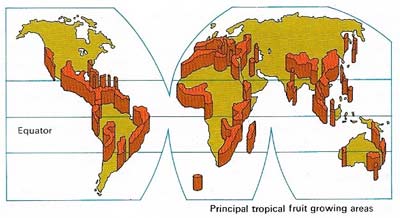
Fig 14. Tropical plantations producing exotic fruits for the world market are found in the inter-tropical zone stretching between the Tropic of Cancer and the Tropic of Capricorn. About one-quarter of the Earth's land surface lies within this region. Many of the crops characteristic of tropical agriculture are also cultivated in warmer parts of the temperate zones. The plantation system is very old in tropical areas. Coffee, tea, coconut palms, pineapples, bananas, and sugar cane are cultivated in this way. Tropical temperatures vary slightly from one month to the next and crops are grown the year round. The mango, citrus, and breadfruit trees are intensively cultivated in Southeast Asia, the fruits of the guava and papaya trees in South America. Improved transportation has sent these luxuries to countries all over the world.
The fruit is the structure that develops from the ovary and accessory parts of a flower after fertilization. True fruits are formed from the carpels, while in false fruits other parts of the flower are involved, for example in the apple the fleshy pulp is derived from the receptacle (see pome). The main function of the fruit is to protect the seeds and disperse them when ripe.
Fruits may simple (derived from the ovary of one pistil), aggregate (formed by a single flower with several separate pistils, e.g., raspberry), or multiple (formed from the flowers of an inflorescence, e.g., fig). Simple fruits may be fleshy (succulent) or dry. Fleshy fruits include the berry and the drupe. Dry fruits may split open to disperse the seeds (dehiscent), the main types being the legume (or pod), follicle, capsule, and silique. Some dry fruits do not break open (indehiscent) the main types here being the achene, grain, samara, and nut.
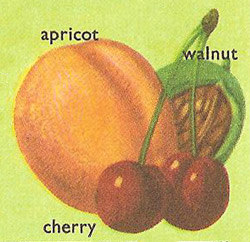 |
| True succulent fruits |
Despite the botanical definition, a fruit-grower's use of the word "fruit" is limited to seed-vessels that are juicy and edible by human beings (Figure 7). He also recognizes nuts as fruit. His chief concerns, therefore, are the quality and size of the edible part, whether he can grow it successfully in his particular area and whether he can sell it at a profit. The fact that seeds are also produced is not relevant, although he knows that their presence is essential for the stimulation and development of the fleshy part he sells.
Fruits have always been an important part of the human diet. Initially, they were gathered directly from the wild, later they were planted trees and bushes so that they grew conveniently near dwelling-places. Finally there was experimentation withcross-fertilizing selected varieties, thereby improving the quality and appearance of the fruit.
Citrus fruits
The orange, lemon, lime, grapefruit, and ugli are citrus fruits – an important group in which the "flesh" is formed by hairs radiating from the seeds. These hairs or pulp-vesicles are swollen and juicy, giving the fruit its characteristic texture. Citrus fruits have their origin in the East. Sweet oranges and lemons were first grown in China and limes in India, and sweet oranges did not appear in the West until the seventeenth century. The grapefruit is thought to be of hybrid origin.
In most citrus fruits the fibrous flesh is eaten and the rind discarded, although in the citron and some others the fruit is gathered mainly for the rind. The rind of citrus fruits contains tiny reservoirs of oil. Orange and lemon rinds give body and flavor to marmalade, and they can be candied and used in confectionery and for giving distinctive flavors to cakes and puddings.
Lime juice was a valuable commodity in the eighteenth and nineteenth centuries when the voyages undertaken by sailing ships were so long that vegetables could not be kept fresh. Lime juice was drunk by the sailors to ward off scurvy, a disease caused by a lack of vitamin C which fruit and vegetables, particularly citrus fruits, contain. The name "limey", given to British sailors of that time, derived from the practice.
Fruits of the rose family
A large number of fruits come from plants of the rose family (Rosaceae); these include the apple (Figure 4), pear (Figure 4), cherry (Figure 3), peach, apricot (Figure 5), and plum. Trees of this family are hardy and thrive in temperate regions. Apples and pears originated in Afghanistan, all varieties of apples being developed from the wild crab apple there. Today apples represent the second most important fruit after the grape and the major producers are the United States, France, Germany, Switzerland, Italy, and the Balkan countries.
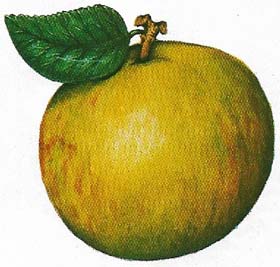 |
| The apple is one of the most important, widely cultivated fruits grown in temperate climates. Shown here is the Cox's Orange Pippin, an eating apple that is widely popular. |
 |
| The plum (Prunus domestica) is a hybrid of two other fruits, the cherry plum and the sloe. The various varieties that have been derived from it are the mainstay of he plum and prune industries of the world. |
 |
| The peach, like the apricot, originally came from China. Both fruits are marketed fresh, dried or canned according to the variety. There are two types of peach –the freestone and the clingstone – which differ according to the ease with which the stone is removed from the flesh. |
 |
| The persimmon is a tomato-shaped fruit grown extensively in China and Japan and introduced to southern Europe and the United States in the 19th century where it is grown only on a small scale. The yellow-red fruit is rich in vitamins A and C and is astringent until it has ripened. |
Larger trees, generally associated with apple orchards (Figure 1) planted after World War II, are becoming less economic because of the high cost of pruning and picking. For this reason most modern orchards have smaller trees planted close together so that work can be done from ground level. This has been made possible by the development of dwarfing and semi-dwarfing rootstocks.
Growers are also experimenting with mechanical pickers but the techniques so far developed damage the fruit too much for it to be usable for high-quality sales or long-term storage. Some apples for cider, however, are gathered by machines.
Pears thrive in warmer temperate regions. In Canada, Australia and South Africa a large proportion of the crop is canned but in. Europe canning is less important. In France, Germany, Switzerland, and England some of the crop is made into a fermented drink called perry.
Fruits of the vine
Grapes are the world's most important perennial fruit and are grown for wine, dessert use or. dried as currants and raisins. Nearly all European and Mediterranean grapes go into wine; in California, more than half of the crop is dried, one-third is used for wine and the remainder is eaten fresh or canned. Each variety of grape is grown for a specific purpose.
Most varieties of melon are derived from the musk melon Cucumis melo (Figure 6) and include the cantaloupe melon, a dimpled and rough-skinned fruit grown in Italy in the fifteenth century from seed brought from Armenia, and the honeydew melon, which probably originated in Southeast Asia and was eaten by the ancient Egyptians and Persians. The watermelon probably had its origin in Africa.
Melons and grapes are susceptible to damage by frost so their open air cultivation is restricted mainly to warm-temperate and subtropical climates.
Temperate fruit trees are nearly all deciduous. Most can resist temperatures of below –7°C (20°F) during winter dormancy and many cannot grow in tropical or subtropical climates because prolonged exposure to low temperatures in the winter is necessary for normal development.
Tropical fruit
Long inhabited by man, the tropics have provided fruits of great antiquity. The great oblong leaves of the banana plant (Figure 13), sometimes 4 meers (13 feet) in length, were said to have hidden the serpent in the Garden of Eden. The banana was known to the Arabs, and the Roman scholar Pliny mentions that Alexander the Great saw it in India in 326 BC. The Islamic conquerors carried the banana to northern Egypt in AD 650 and later on to West Africa. Fifteenth-century slave-traders took it to the Canary Islands and from there it was introduced to the Americas. The banana finally reached Mexico with the Spanish conquistadores in 1531. There are now more than 100 varieties of the cultivated banana. Besides the sweet dessert fruits, there are the plantains for cooking and a particular form grown for making beer.
No tropical fruit, however, is as well-traveled as the coconut (Figure 8E), famed throughout the world as one of man's most bountiful providers. Growing along sandy coasts, the coconut palm's ripe nuts are swept by oceans to many tropical shores. The soft eye of the husk produces a plant which quickly takes root in new ground.
Staff of life
The coconut not only contains an edible kernel and a natural, refreshing milk, but its fermented sap makes a heady toddy which, when distilled, becomes a potent spirit.
One of the most important oils is obtained from copra – the dried kernel, or meat, of the coconut. Coconut oil is used in the manufacture of soaps and detergents, margarines and edible oils, and a host of other products. The husk itself yields coir, a tough fiber used 'in making ropes, mats and baskets. Mature palm leaves are also utilized in basketry and thatching and the trunk of the coconut tree is used as rough timber for constructing native huts and fences.
The breadfruit (Figure 11A) is another invaluable tree and is a staple food throughout the islands of Polynesia. The pulp of its fruit, roasted in its skin before it is fully ripe, tastes like freshly baked wheat bread. The first explorer to mention breadfruit was Captain William Dampier on his return from Guam in 1688. Captain William Bligh's mission in 1786 was to bring breadfruit plants from the Society Islands to the West Indies. The story of the mutiny on the Bounty is well known, but Captain Bligh's later voyage in 1791 was successful and the breadfruit is now cultivated from Florida to Brazil.
Symbol of fertility
One of the oldest Semitic representations of life and abundance was the multi-seeded fruit of the pomegranate tree (Figure 10C). King Solomon had an orchard of the fruit and the pillars of his temple were decorated with carved pomegranates. In Babylon it was served at wedding feasts and it played a similar role as a symbol of love and fertility in the Far East. The fat, ripe fruits were thrown on the floor of the bridal chamber so that the seeds should burst from their smooth skins. Centuries later the prophet Mohammed claimed another virtue for the pomegranate. He said that eating the fruit would banish envy and hatred. The pomegranate also became the emblem of Granada and Ibn-al-Awam, a thirteenth-century Moor, recorded some ten varieties of the fruit that flourished in southern Spain at the time. Spanish colonists probably took the plant to the New World and today it is grown in gardens from the warmer areas of North America to Chile.
Fruits of hallowed legend
Throughout history the fig (Figure 10A) has played an important role in mythological tales. Adam and Eve covered their nakedness with fig leaves and it is thought that the Tree of Enlightenment which grew in Buddha's garden may have been the bo, or sacred fig. In Latin myth the fig was held sacred to Bacchus, god of wine, and was used in many religious ceremonies. It was also regarded by the Romans as a badge of prosperity because it grew over the wolf's cave where Romulus and Remus, the legendary founders of Rome, were discovered.
The fig is undoubtedly one of the earliest trees cultivated by man. It spread all over the Aegean and Levant centuries ago. It formed part of the staple diet of the Greeks and both fresh and dried figs are still so widely used in the Mediterranean that the fruit is commonly called "the poor man's food". In southern Asia the leaves, bark and fruit of the sacred fig are used in folk medicine but in India it is planted as a religious object and revered by Brahmans and Buddhists alike.
The mango (Figure 11C) is yet another fruit held in great esteem in India. Akbar, the Mogul emperor who ruled at Delhi in the sixteenth century, planted an orchard of 100,000 mango trees and one of the ancient names of the fruit stems from a Sanskrit word meaning food. Buddha also had a mango grove in which he found solitude for philosophical thought. The English name comes from man-kay or man-gay, a Tamil word adopted by the Portuguese in India. The tree did not appear in the Western Hemisphere until about 1700, when it was planted in Brazil. The juicy mango varies in color from yellow to orange and has a succulent spicy flavor.


